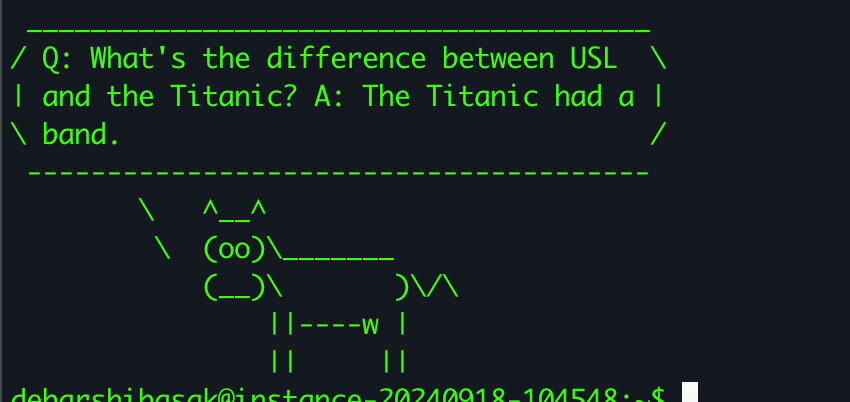In this blog we explore 9 fun and nerdy ways to make your SSH experience cool (and somewhat ridiculous).
🧙♂️ Use cowsay and fortune to Bless Your SSH
Install fortune
sudo apt update sudo apt install fortuneFor offensive or riddles
sudo apt install fortune-mod fortunesInstall cowsay
sudo apt install cowsayWhile SSH-ing into a server, run:
fortune | cowsay | ssh user@hostYou should see

🖼️ ASCII Art Splash Screen
You can customize your login experience by adding ASCII art to your terminal every time you SSH into your server. Here's how to do it using figlet.
- Install figlet
Debian/Ubuntu:
sudo apt update && sudo apt install figlet- Generate ASCII art:
- Edit the MOTD file:
- Paste the ASCII output, for example:

Save and exit. It’ll show up for all users at login.
🛰️ Run SSH Through a Satellite Relay (Using a Proxy)
You can use HTTP or SOCKS Proxy or SSH Relay or ProxyJump or sshuttle If the satellite network provides only proxy access:
In .ssh/config
Host remote HostName remote-server User user ProxyJump user@satellite-relayAnd then run,
ssh remote🧙 Use sshpass with a Wand Gesture (or Smart Device)
Create a trigger script
Create an ssh script
#!/bin/bash # wand_ssh.sh sshpass -p 'YourPasswordHere' ssh user@hostnameCreate a python script to trigger SSH.
import serial, subprocess ser = serial.Serial('/dev/ttyUSB0', 9600) while True: line = ser.readline().decode().strip() if line == "gesture:unlock": subprocess.run(["/path/to/wand_ssh.sh"])📟 Sound effects when doing SSH
For linux:
alias ssh='aplay ~/sounds/soundeffect.wav && command ssh'Alternatively,
You can do Text-to-Speech.
For linux,
espeak "Establishing connection" && ssh user@hostFor macos,
say "Establishing connection" && ssh user@host🥷 Alias It with a Ridiculous Command
For eg.
alias initiate_protocol_x='afplay ~/modem.wav && ssh [email protected]'Then run:
initiate_protocol_x🐍 Snake Game First, Then SSH
Install pythong
sudo apt install python3Create snake_then_ssh.py
#!/usr/bin/env python3 import curses from curses import KEY_RIGHT, KEY_LEFT, KEY_UP, KEY_DOWN from random import randint import subprocess import sys import os def play_snake(stdscr): curses.curs_set(0) stdscr.nodelay(1) stdscr.timeout(100) sh, sw = stdscr.getmaxyx() win = curses.newwin(sh, sw, 0, 0) win.keypad(1) snk_x = sw//4 snk_y = sh//2 snake = [[snk_y, snk_x], [snk_y, snk_x-1], [snk_y, snk_x-2]] food = [randint(1, sh-2), randint(1, sw-2)] win.addch(food[0], food[1], '🍎') key = KEY_RIGHT score = 0 while True: next_key = win.getch() key = key if next_key == -1 else next_key head = [snake[0][0], snake[0][1]] if key == KEY_DOWN: head[0] += 1 if key == KEY_UP: head[0] -= 1 if key == KEY_LEFT: head[1] -= 1 if key == KEY_RIGHT: head[1] += 1 snake.insert(0, head) if head == food: score += 1 food = None while food is None: nf = [randint(1, sh-2), randint(1, sw-2)] food = nf if nf not in snake else None win.addch(food[0], food[1], '🍎') else: tail = snake.pop() win.addch(tail[0], tail[1], ' ') if head in snake[1:] or head[0] in [0, sh] or head[1] in [0, sw]: msg = " 💀 Game Over - Score: {} ".format(score) win.addstr(sh//2, sw//2 - len(msg)//2, msg) win.refresh() curses.napms(2000) return False win.addch(head[0], head[1], '■') def main(): result = curses.wrapper(play_snake) subprocess.run(["ssh", "[email protected]"]) if __name__ == "__main__": main()Run it
chmod +x snake_then_ssh.py ./snake_then_ssh.py🌐 QR Code Login
🛠️ Generate QR Code:
qrencode -o ssh-login.png 'ssh [email protected] -p 2222'Or plain terminal QR:
qrencode -t ANSIUTF8 'ssh [email protected] -p 2222'you can do
echo -e "\nScan to SSH into this system:" qrencode -t ANSIUTF8 "ssh user@$(hostname -I | awk '{print $1}')"Scan QR to Launch SSH on Desktop
sudo apt install zbar-toolsScript to Scan and Connect:
#!/bin/bash zbarcam --raw | while read sshcmd; do echo "Connecting with: $sshcmd" eval "$sshcmd" break done🎮 SSH via a Game Console Emulator
Running a guest OS inside a game console emulator allows for experimentation, development, and modding. This guide covers supported consoles and how to install Linux or other OS variants in an emulated environment.
🐧 Run Linux on GameCube/Wii with Dolphin Emulator + SSH (Optional)
Bring retro computing to life by running a guest Linux OS inside the Dolphin emulator, originally built for Nintendo GameCube/Wii. This guide walks you through booting Linux and optionally enabling SSH access from within the emulated environment.
🎮 What You’ll Do
- Boot a lightweight Linux OS on emulated Wii/GameCube hardware
- Access a terminal inside Dolphin
- Optionally enable SSH client or server for remote access or outbound connections
✅ Requirements
| 🐬 Dolphin Emulator | Download here |
| 🐧 Wii-Linux ISO/DOL | Linux build for Wii/GameCube (e.g., Mini Slackware) |
| 💾 Virtual SD card (optional) | To persist files or add SSH configs |
| 🎧 Modem sound (optional) | For BBS-style retro flavor |
🔧 Setup Steps
1. Install Dolphin Emulator
Download and install Dolphin from https://dolphin-emu.org.
2. Download Wii-Linux Image
Get a bootable .dol or .elf from:
Example:
wget https://example.com/wii-linux/boot.dol -O boot.dol 3. Launch the Image in Dolphin Open Dolphin Go to File > Open or Tools > Load DOL/ELF Select your boot.dol Dolphin should now boot into a lightweight Linux shell..png)




